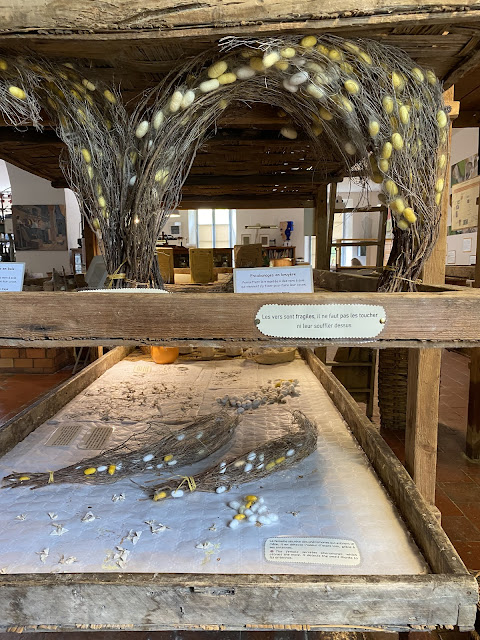I promise I'm not spending all my time in textile related museums, I'm on holiday and as I usually do, I went to the closest tourist information centre and picked up some leaflets that might be in our interest. Without any planning I've stumbled upon the French Silk Museum, an hour away from our house. Tell me that in a similar situation you would have done it differently!
It's our third year holidaying in this region, started in 2020 at the cause of the pandemic, and discovered it is not that awful. Yes there are some things that bug me, and this year a new one is traffic, but overall this region (South of France) still has a lot to offer. To clarify, we are not on Cote D'Azur, which to me is a bit overrated, we are closer to the border region with Spain.
Now, on to the museum. On its name Musée de la Soie de Saint Hippolyte du Fort, it is a small one in comparison to other museums I've visited, but it is very interesting and abundant with information. You see, in Romania, silk, particularly one made out of silk worms is very sought after, but the craft is almost lost. There is still one family who makes objects out of silk, but that's it. The situation is not that different in France, there are some manufactures and some local artists who still use silk, but not to the scale it once had.
Apparently, at one point (1853) the silk produced in this region (Cévennes) was 85% of the whole silk produced in France (26,000 tons of cocoons). After that it slowly declined until 1938 when the artificial silk (nylon) was invented. There were so many micro silk mills in that region because of the proper climate, because there were planted a lot of mulberry trees, what the worms eat, and because the attics of most houses were aery. Even to this day when you see on a house round windows at the attic, that was possibly a silk mill at one point.
In 1978 the Association for the development of the silk industry in Cévennes decided to not let this craft go extinct and created this museum and started teaching courses on how to take care of the worms and create silk.
The museum has three sections which follow the process of production of silk from silkworm feeding room to the finished product and a particular interest for me, the silk fibres and silk embroidery. Unfortunately it is machine embroidery, but interesting none the less.

Spoiler (in case you thought otherwise) the silkworms are killed in order to extract the silk, what you see in pictures are worms selected for the breeding process. Yes they were alive, I've recorded them, but posted the movie only on Instagram, as this platform is a bit fussy when you want to mix mediums, photo and video.

I've liked that, where possible, the explanations were in French, but also in English. Here is how the cocoons rest on branches.

I was impressed by the history of silk production in the area and you can clearly see that children also worked in those micro factories.
Also women with small children
I've tried to take as many pictures as possible, but will not post them all because you have to see for yourself the whole process and appreciate more when you encounter natural silk.
Silk threads, the whole process from cocoon to thread
And then from thread to fabric.
Silk embroidery
Natural dyes on different types of threads
A raw silk that looks very similar to the one we are using on embroidery.
A corner where you could touch
Would I come from Luxembourg to visit this particular museum? Clearly NO. Would I visit it once in the region? Definitely YES. It is interesting not only for textile enthusiasts, it costs, I think, 6 euros, to visit and you can spend two hours at least reading everything they exhibit. Also if you like machines, as my husband, you will not be disappointed. I didn't even took pictures of the machines. Sorry.
I hope you liked reading my little post as much as I loved putting it together. I am more active on Instagram
@mademoiselle.ralu
 pt. ca voiam sa ii port fix azi (miercuri 14.09) cand ma intalneam cu fetele.
pt. ca voiam sa ii port fix azi (miercuri 14.09) cand ma intalneam cu fetele.














